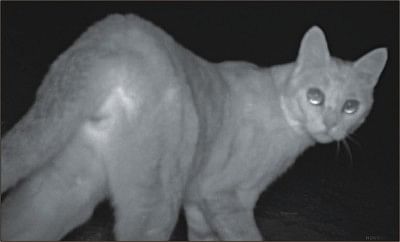Elusive Saharan cheetah

A camera trap recently captured the elusive Saharan cheetah in a vast desert in Niger, Africa
The mysterious Saharan Cheetah is an ultra-secretive elusive creature. A sub-species of cheetah, it is also known as the Northwest African cheetah. It was only back in 2009 that scientists from the Zoological Society of London were able to photograph one for the first time using a nighttime camera trap in the Algerian deserts. And very recently (December, 2010) scientists from the Saharan Conservation Fund (SCF) photographed the wild cat in the deserts of the Termit Massif, Niger. As these cats are very rare, the International Union for Conservation of Nature (IUCN) has classified them as critically endangered species. And naturally the image captured by the scientists from SCF has created a great enthusiasm among the conservationists as many believe that fewer than 10 of such cats survive in the harsh deserts of Termit, Niger. Experts also believe that the total number of Saharan Cheetah (scientific name Acinonyx jubatus hecki) is somewhere around 250.
The scientists from the SCF took the photograph of the wild cat as part of the Saharan Carnivore Project (covering an area of 2,800 square kilometers) led by researcher John Newby and Tim Wacher, an effort supported by the University of Oxford. And using spot patterns which are unique to each individual of this cheetah species, this survey identified four different Saharan cheetahs and managed to take the picture of only one.
Now, what is so special about this particular creature? The truth is almost nothing is known about the Saharan cheetah until now. This Northwest African cheetah is found in the Sahara desert and savannahs of North and West Africa including Algeria, Niger, Mali, Benin, Burkina Faso and Togo. But it is not yet known if Saharan cheetahs are more closely related to other cheetahs in Africa, or those living in Iran, which make up the last remaining wild population of Asiatic cheetahs. It has been found that the Saharan cheetahs are quite different in physical appearance form other common cheetahs with their distinct nearly white color with spot patterns that fade from black over the spine to light brown on the legs. But as far as behavioral pattern is concerned, according to Dr. Thomas Rabeil of SCF, "Very little is known about the behavioral differences between the two cheetahs, as they have never been studied in the wild."
Experts believe that this wild cat endures extremely high temperatures (113 degrees Fahrenheit or 45 degrees Celsius) of the desert and appears to survive without any permanent source of water which is quite extraordinary. Scientists believe that these creatures probably satisfy their water requirements through the moisture in their prey along with having extremely effective physiological and behavioral adaptive capabilities. Numerous attempts have been made to track down the Saharan cheetahs, most of which are unsuccessful. This clearly suggests that these wild cats roam considerable distances to hunt their preys. These preys include antelopes such as the addax, Dorcas Gazelle, Rhim Gazelle and Dama Gazelle. And it is the indiscriminate poaching of this wild species that has rendered it so endangered. According to John Newby "They are suspected of taking goats and even baby camels (owned by nomad tribes), and as a result are persecuted just like most other large predators". The researcher concludes by adding, "The more we know about the animal, the better we can conserve it, including pinpointing key areas for extra protection. The cheetah's presence adds weight to arguments for the entire zone's protection as a nature reserve and strengthens our ability to raise support for conservation activities".

 For all latest news, follow The Daily Star's Google News channel.
For all latest news, follow The Daily Star's Google News channel. 



Comments